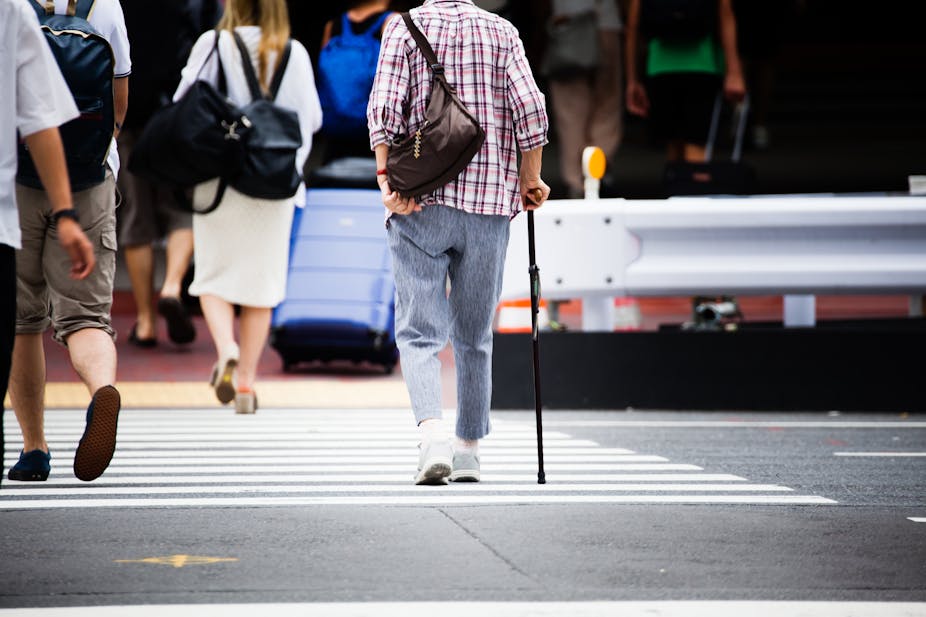At the Habitat III conference in Quito, the foundation of the Federation Internationale de l'Automobile called for a “children-first” approach when designing the world’s roads with pedestrians in mind. But there is another group that urgently needs consideration too: the over-70s.
One of the key concerns for people as they age is mobility. Though certainly many are happy to drive – and do so safely – or make use of public transport, there is still the issue of being physically mobile. Roads were built to facilitate getting masses of people from A to B quickly and conveniently, and yet the way that pathways are managed at present is not the most helpful for all who use them.
In the UK, people over the age of 70 make up 11.8% of the population, and account for around 8% of pedestrian activity. Older people also count for a staggering 42.8% of all pedestrian fatalities: 191 deaths from 446 in total. That means almost half the pedestrians killed on roads come from just over 11% of the population.
Quite evidently there are simple things that can be done. Older people report feeling unsafe walking near busy and fast traffic so road speeds could be slowed, and more space made to walk away from fast vehicles. The upkeep of pavements could also be improved, to stop people from falling, and make sure they are accessible to those with poor balance or eyesight and at different times of the year; in the winter months main roads are gritted for vehicles but pavements for pedestrians are not.
A look at police data, collected at the scene of road collisions in Britain, shows that failure to judge vehicle speed is a significant factor in older people’s road collisions as pedestrians. This correlates with data in Australia, France, the Netherlands and several other countries. Generally, older pedestrians look less at traffic and accept significantly smaller gaps in traffic when crossing the road than younger pedestrians.
Time to cross
In the UK, there five types of crossing, each slightly different from the other: zebra, pelican, puffin, toucan and pegasus. The most common is the Pelican crossing, which is a traffic lighted crossing point with green and red phases for drivers and pedestrians. Government guidelines suggest that the time for the pedestrians’ green phase should be set at a walking speed of between one to 1.22 metres (around 4ft) per second – a speed found almost universally across the world. Despite this, the green phase for UK pedestrians is generally around four seconds, with a further six seconds of flashing green, giving people ten seconds to cross the road. My research has identified that this simply isn’t long enough. I found that 88% of people over 70 couldn’t cross the road given a time of 1.22 metres a second. For women, the statistic is even more stark: 94% couldn’t cross in this time. Those in poor health and, interestingly, those with lower socio-economic backgrounds walked much slower, making it harder for them to cross the road in time.
Previous research has found similar results, suggesting that older people’s average speeds are between 0.7 and 0.9 metres a second. What may be regarded as a trivial issue by some can actually be hugely detrimental to the lives of older people: anxiety over crossing times can stop older people going out, making them housebound, increasing sedentary behaviour, loneliness and isolation.
Making a difference
There has been some recognition of the plight of pedestrians across the world. New York City, through its Safer Streets for Seniors campaign, is evaluating the pedestrian environment in light of older people’s road safety. The state of Victoria, Australia, recently pledged to increase the length of the pedestrian phase on some of its crossings. And yet more can be done globally. Countries like the UK have an opportunity to show off their age-friendly credentials and create an environment that is more accessible for the world’s ageing society.
As the population of older people increases, it is vital that this issue is resolved well before then. Lobbying from groups wanting to increase crossing times has already begun, while some improvements are being made with the introduction of puffin crossings.
Walking is not only beneficial for health but also enables connections. As the world ages, it is vital that we help older generations continue to enjoy their lives – and ensuring accessibility and safety for pedestrians is a crucial part of this.

